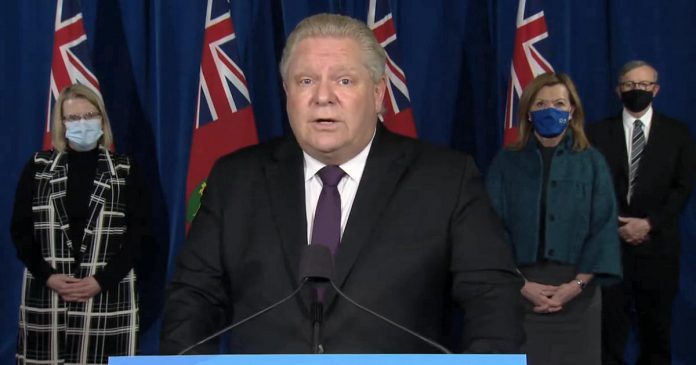The Ontario government is extending its stay-at-home order for another week for all public health regions in Ontario, except for three in eastern Ontario. As other health units gradually move back into the previous colour-coded COVID-19 response framework, the province will implement a new “emergency brake” system to respond to outbreaks of more contagious COVID-19 variants.
Ontario Premier Doug Ford made the announcement at a media briefing at Queen’s Park on Monday (February 8).
“We’re not clear of this storm yet,” Ford said. “Hospital ICUs in some parts of the province are still under immense pressure. We’re getting hit with new variants of COVID-19, and there are significant delays in getting our vaccine supply. This is a critical time.”
“We can find a way forward, but we need a plan that continues to protect the health and safety of each and every person in this province, while ensuring more businesses can safely reopen and getting more people back to work,” Ford added.
As of 12:01 a.m. on Wednesday (February 10), the stay-at-home order will end for the following three public health unit regions, which will move back into the “Green-Prevent” level of the province’s COVID-19 response framework that was in effect prior to the province-wide shutdown implemented on Boxing Day:
Hastings Prince Edward Public Health
Kingston, Frontenac and Lennox & Addington Public Health, and
Renfrew County and District Health Unit.
For the rest of Ontario’s public health unit regions, the stay-at-home order (which has been in effect since January 14) will remain in place until next Tuesday (February 16) — except for Toronto, Peel, and York, where it will remain in place until Monday, February 22nd.
At those times, the government will make final decisions on which public health unit regions will move back into the COVID-19 response framework, and at what level, based on public health indicators.
Ford also announced Ontario will not be extending the province’s second state of emergency, declared on January 12, past Tuesday (February 9).
“We can’t return to normal, not yet, not while our hospitals could still be overwhelmed,” Ford added. “But we can transition out of the province-wide shutdown. Today I’m announcing the declaration of emergency will not be extended past February 9th.”
Enforcement of residential evictions will remain paused in the public health unit regions where the provincial stay-at-home order remains in effect.
Because of ongoing concerns about the risk of more contagious COVID-19 variants, the province is also implementing a new “emergency brake” system when public health unit regions move back into the COVID-19 response framework.
The “emergency brake” system will allow for immediate action if a public health unit region experiences rapid acceleration in COVID-19 transmission or if its health care system risks becoming overwhelmed. If this occurs, Ontario’s chief medical of health and the local medical officer of health may advise to immediately move a region into Grey-Lockdown status to interrupt transmission.
In advance of public health regions moving back into the colour-coded COVID-19 response framework, the government is also making some changes to the framework to allow for in-store shopping at non-essential retail stores even in the most restrictive levels, with additional public health and safety measures in place.
For example, for the Grey-Lockdown level, there will be a 25 per cent capacity limit on retail stores (including big box stores). This is in addition to the existing 50 per cent capacity limit for supermarkets and other stores that primarily sell groceries, convenience stores, and pharmacies.
For the Red-Control level, there will be a 75 per cent capacity for supermarkets and other stores that primarily sell groceries, convenience stores, and pharmacies, and a 50 per cent capacity limit for all other retail businesses that engage in retail sales to the public, including big box stores.
































